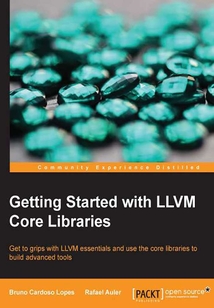首頁(yè) > 計(jì)算機(jī)網(wǎng)絡(luò) >
編程語(yǔ)言與程序設(shè)計(jì)
> Getting Started with LLVM Core Libraries最新章節(jié)目錄
舉報(bào) 

會(huì)員
Getting Started with LLVM Core Libraries
最新章節(jié):
Index
Thisbookisintendedforenthusiasts,computersciencestudents,andcompilerengineersinterestedinlearningabouttheLLVMframework.YouneedabackgroundinC++and,althoughnotmandatory,shouldknowatleastsomecompilertheory.Whetheryouareanewcomeroracompilerexpert,thisbookprovidesapracticalintroductiontoLLVMandavoidscomplexscenarios.Ifyouareinterestedenoughandexcitedaboutthistechnology,thenthisbookisdefinitelyforyou.
目錄(87章)
倒序
- 封面
- 版權(quán)頁(yè)
- Credits
- About the Authors
- About the Reviewers
- www.PacktPub.com
- Support files eBooks discount offers and more
- Preface
- What this book covers
- What you need for this book
- Who this book is for
- Conventions
- Reader feedback
- Customer support
- Chapter 1. Build and Install LLVM
- Understanding LLVM versions
- Obtaining prebuilt packages
- Building from sources
- Summary
- Chapter 2. External Projects
- Introducing Clang extras
- Using the DragonEgg plugin
- Summary
- Chapter 3. Tools and Design
- Introducing LLVM's basic design principles and its history
- Understanding LLVM today
- Interacting with the compiler driver
- Using standalone tools
- Delving into the LLVM internal design
- Writing your first LLVM project
- Navigating the LLVM source – general advice
- Summary
- Chapter 4. The Frontend
- Introducing Clang
- Learning the frontend phases with Clang
- Putting it together
- Summary
- Chapter 5. The LLVM Intermediate Representation
- Overview
- Exercising basic tools to manipulate the IR formats
- Introducing the LLVM IR language syntax
- Writing a custom LLVM IR generator
- Optimizing at the IR level
- Summary
- Chapter 6. The Backend
- Overview
- Learning the backend code structure
- Knowing the backend libraries
- Learning how to use TableGen for LLVM backends
- Understanding the instruction selection phase
- Scheduler
- Machine instructions
- Register allocation
- Prologue and epilogue
- Understanding the machine code framework
- Writing your own machine pass
- Summary
- Chapter 7. The Just-in-Time Compiler
- Getting to know the LLVM JIT engine basics
- Introducing the llvm::JIT framework
- Introducing the llvm::MCJIT framework
- Using LLVM JIT compilation tools
- Other resources
- Summary
- Chapter 8. Cross-platform Compilation
- Comparing GCC and LLVM
- Understanding target triples
- Preparing your toolchain
- Cross-compiling with Clang command-line arguments
- Generating a Clang cross-compiler
- Testing
- Additional resources
- Summary
- Chapter 9. The Clang Static Analyzer
- Understanding the role of a static analyzer
- Testing the static analyzer
- Extending the static analyzer with your own checkers
- More resources
- Summary
- Chapter 10. Clang Tools with LibTooling
- Generating a compile command database
- The clang-tidy tool
- Refactoring tools
- Writing your own tool
- More resources
- Summary
- Index 更新時(shí)間:2021-09-03 09:44:25
推薦閱讀
- Learning Microsoft Windows Server 2012 Dynamic Access Control
- 現(xiàn)代C++編程:從入門到實(shí)踐
- 流量的秘密:Google Analytics網(wǎng)站分析與優(yōu)化技巧(第2版)
- Moodle Administration Essentials
- Linux C/C++服務(wù)器開(kāi)發(fā)實(shí)踐
- Visual FoxPro 程序設(shè)計(jì)
- Learning Elixir
- 深度強(qiáng)化學(xué)習(xí)算法與實(shí)踐:基于PyTorch的實(shí)現(xiàn)
- 劍指MySQL:架構(gòu)、調(diào)優(yōu)與運(yùn)維
- ANSYS Fluent 二次開(kāi)發(fā)指南
- C語(yǔ)言程序設(shè)計(jì)
- Learning Node.js for .NET Developers
- Java圖像處理:基于OpenCV與JVM
- Mastering Leap Motion
- C語(yǔ)言程序設(shè)計(jì)教程
- 精益軟件開(kāi)發(fā)管理之道
- Java EE 7 Development with WildFly
- VC++ 2008專題應(yīng)用程序開(kāi)發(fā)實(shí)例精講
- Learning Swift
- 亮劍Java Web項(xiàng)目開(kāi)發(fā)案例導(dǎo)航
- Mastering Assembly Programming
- Tableau數(shù)據(jù)可視化從入門到精通
- C#灰帽子:設(shè)計(jì)安全測(cè)試工具
- Deep Learning with Theano
- Learning C# by Developing Games with Unity 5.x(Second Edition)
- Cocos2d—X 案例開(kāi)發(fā)大全
- Learning iPhone Game Development with Cocos2D 3.0
- Microsoft Dynamics CRM 2011 Reporting
- MariaDB Essentials
- QlikView for Developers

